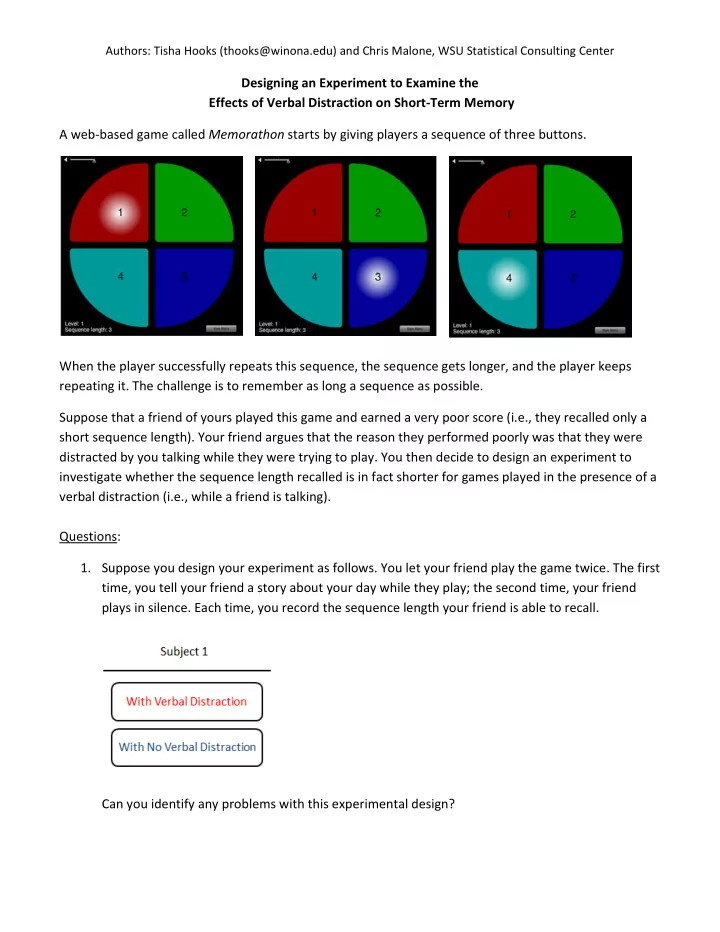

Authors: Tisha Hooks (thooks@winona.edu) and Chris Malone, WSU Statistical Consulting Center Designing an Experiment to Examine the Effects of Verbal Distraction on Short ‐ Term Memory A web ‐ based game called Memorathon starts by giving players a sequence of three buttons. When the player successfully repeats this sequence, the sequence gets longer, and the player keeps repeating it. The challenge is to remember as long a sequence as possible. Suppose that a friend of yours played this game and earned a very poor score (i.e., they recalled only a short sequence length). Your friend argues that the reason they performed poorly was that they were distracted by you talking while they were trying to play. You then decide to design an experiment to investigate whether the sequence length recalled is in fact shorter for games played in the presence of a verbal distraction (i.e., while a friend is talking). Questions: 1. Suppose you design your experiment as follows. You let your friend play the game twice. The first time, you tell your friend a story about your day while they play; the second time, your friend plays in silence. Each time, you record the sequence length your friend is able to recall. Can you identify any problems with this experimental design?
Authors: Tisha Hooks (thooks@winona.edu) and Chris Malone, WSU Statistical Consulting Center 2. Upon further reflection, you realize that your first design lacks replication (i.e., the repetition of an experimental condition). You decide to revise your experiment by making your friend play the game 12 times. The first six times, you continue to tell your friend a story about your day; the last six times, your friend plays in silence. You record the sequence length your friend is able to recall each time they play the game. Identify any issues that may arise with this experimental design.
Authors: Tisha Hooks (thooks@winona.edu) and Chris Malone, WSU Statistical Consulting Center 3. Once again, upon further reflection you recognize that there are problems with your previous design proposal. Though it seemed to include replications of each experimental condition, you have come to realize that repeated measures taken on the same subject aren’t necessarily replicates. Also, the previous design proposal lacks randomization . You know how to fix both of these issues, but now you are stuck choosing between two competing designs. Design A: You recruit 12 subjects and randomly assign half of them to hear a tape ‐ recorded version of the story about your day while they play the game; the other half play the game in silence. For each subject, you record the sequence length they are able to recall. Design B: You recruit 6 subjects. Each one will play the game twice: once while hearing a tape ‐ recorded version of the story about your day, and the other in silence. Half of the subjects are randomly assigned to play the game with the verbal distraction first; the other half are randomly assigned to play the game in silence first. Each time the game is played, you record the sequence length that was recalled. Which design do you think is better, A or B? Why?
Authors: Tisha Hooks (thooks@winona.edu) and Chris Malone, WSU Statistical Consulting Center
Authors: Tisha Hooks (thooks@winona.edu) and Chris Malone, WSU Statistical Consulting Center Don’t Let Bad Data Ruin Your Project Good vs. Bad Measurements Science fair projects are a great way to learn science because you are doing science. However, not all science fair projects are great and sometimes projects do not turn out like they are supposed to. Sometimes the research hypothesis is wrong or sometimes the data collected is incomplete, messy, or does not relate to your research hypothesis. Measurements are Everywhere Example #1: Measurements are used in places we might not even expect. Consider the following situation regarding seeding of teams for the Minnesota State High School Soccer Tournament. Soccer Tournament Bracket Top 4 teams are identified and placed in tournament bracket Remaining teams are randomly placed in bracket.
Authors: Tisha Hooks (thooks@winona.edu) and Chris Malone, WSU Statistical Consulting Center Your Turn… Consider the following schools and their respective records from the 2010 Girls Soccer Tournament. Identify the top 4 teams and place them in the bracket accordingly. 2010 Girls Class A Soccer Tournament Participants Complete the bracket for the top 4 teams. Name of School Record Rogers H.S. 21 ‐ 0 ‐ 0 Benilde ‐ St. Margaret's School 19 ‐ 0 ‐ 1 Chisago Lakes Area H.S. 15 ‐ 5 ‐ 1 Mahtomedi H.S. 17 ‐ 0 ‐ 4 Saint Peter H.S. 13 ‐ 5 ‐ 1 Blake School (The) 17 ‐ 1 ‐ 2 East Grand Forks H.S. 19 ‐ 1 ‐ 1 La Crescent H.S. 17 ‐ 4 ‐ 1 More Relevant Examples Mold Experiment o Research Hypothesis: Where does mold grow faster? o Measurement Issue: o Solution: Plant Experiment o Research Hypothesis: If plants are not watered, will ones with plant food in the soil live longer? o Measurement Issues: o Solution:
Recommend
More recommend